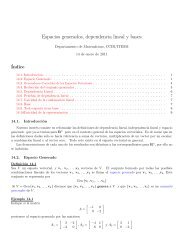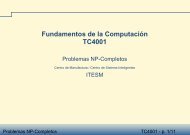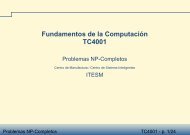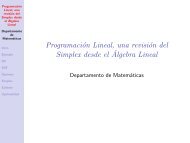Teoría de la Dimensión en Espacios Lineales Presentación para ...
Teoría de la Dimensión en Espacios Lineales Presentación para ...
Teoría de la Dimensión en Espacios Lineales Presentación para ...
You also want an ePaper? Increase the reach of your titles
YUMPU automatically turns print PDFs into web optimized ePapers that Google loves.
Definamos<br />
A 3 = {x 3 , x 2 , x 1 , y 1 , . . . , y m−2 }<br />
Así<br />
◮ g<strong>en</strong>era a V (x 3 ∈ V ),<br />
◮ es linealm<strong>en</strong>te <strong>de</strong>p<strong>en</strong>di<strong>en</strong>te,<br />
◮ su primer elem<strong>en</strong>to x 3 ≠ 0<br />
por tanto, hay un vector y i3 que es<br />
combinación <strong>de</strong> los anteriores, asumamos<br />
que es y m−2 . Observe que<br />
x 1 no pue<strong>de</strong> ser combinación lineal<br />
<strong>de</strong> x 3 y <strong>de</strong> x 2 y que tampoco x 2 pue<strong>de</strong><br />
ser combinación lineal <strong>de</strong> x 3 . Por<br />
tanto,<br />
B 3 = {x 3 , x 2 , x 1 , y 1 , . . . , y m−3 }<br />
g<strong>en</strong>era a V .<br />
Lema 1: Si v ∈ G<strong>en</strong>{v 1 , . . . , v n}, <strong>en</strong>tonces<br />
G<strong>en</strong>{v, v 1 , . . . , v n} = G<strong>en</strong>{v 1 , . . . , v n}<br />
Lema 2: Si v ∈ G<strong>en</strong>{v 1 , . . . , v n}, <strong>en</strong>tonces es linealm<strong>en</strong>te<br />
<strong>de</strong>p<strong>en</strong>di<strong>en</strong>te el conjunto<br />
J = {v, v 1 , . . . , v n}<br />
Lema 3: Si el conjunto J = {v 1 , . . . , v n} es linealm<strong>en</strong>te<br />
in<strong>de</strong>p<strong>en</strong>di<strong>en</strong>te, <strong>en</strong>tonces:<br />
a<br />
b<br />
ninguno <strong>de</strong> los vectores v i es el vector<br />
cero, y<br />
cualquier subconjunto <strong>de</strong> J es también<br />
linealm<strong>en</strong>te in<strong>de</strong>p<strong>en</strong>di<strong>en</strong>te.<br />
Lema 4: Si el conunto J = {v 1 , v 2 , . . . , v n} es<br />
linealm<strong>en</strong>te <strong>de</strong>p<strong>en</strong>di<strong>en</strong>te y v 1 ≠ 0, <strong>en</strong>tonces existe<br />
un vector v io que es combinación lineal <strong>de</strong> los<br />
vectores anteriores v 1 , . . . , v io −1. (Así i o > 1)<br />
Lema 5: Si el conunto J = {v 1 , v 2 , . . . , v n} es<br />
linealm<strong>en</strong>te in<strong>de</strong>p<strong>en</strong>di<strong>en</strong>te y v /∈ G<strong>en</strong> (J ), <strong>en</strong>tonces<br />
J ∪ {v} es linealm<strong>en</strong>te in<strong>de</strong>p<strong>en</strong>di<strong>en</strong>te.














